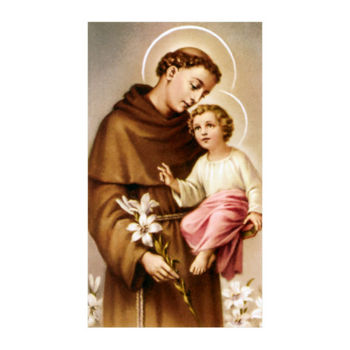Anthony Of Padua
 From Conservapedia
From Conservapedia 
St. Anthony of Padua (born 1195, died 1231) was a simple and humble friar who preached the Good News lovingly and with fearless courage. The youth whom his fellow friars thought was uneducated became one of the great preachers and theologians of his day. He was a man of great penance and apostolic zeal. He is the Patron of the Poor and the Patron of Seekers of Lost Articles. St. Anthony is typically portrayed holding the child Jesus. Pope Pius XI made St. Anthony a Doctor of the Church in 1946. He is one of only 33 to receive the title.
Contents
- 1 Early life
- 2 Franciscan Life
- 3 Traditions
- 4 Miracles
- 5 External links
- 6 References
Early life[edit]
St. Anthony was named Ferdinand, born in Lisbon, Spain, now Portugal. His parents, Martin Bouillon is a descendant of the renowned Godfrey de Bouillon, commander of the First Crusade and his mother, Theresa Tavejra, descendant of Froila I, fourth king of Asturia, Spain.[1] They were one of the most prominent families of the city.
At the age of 15 he entered the religious order of St. Augustine.
Franciscan Life[edit]
After 10 years, he left the Augustinian Order for the Fransican Order. St. Anthony made this decision after he encountered five Franciscan priests en route to Morocco to preach the good news of Christ. All five ended up martyred by torture and beheadings. This inspired St. Anthony to preach abroad "...that I may gain the crown of the holy martyrs." [2] He was granted his wish and departed for the land of Saracens. Though, he became seriously ill and after several months realized he had to go home. He never made it back home. His ship ran off course due to bad weather and months later, he ended up in Sicily where he was nursed back to health by the friars at the city of Messina.
His quiet life of prayer and penance at the hermitage near Montepaolo was exchanged for that of a public preacher. St. Francis of Assisi heard of his great knowledge and holiness after a speech he gave in 1222 and was assigned to preach in Northern Italy. He lived and preached in Padua, a major population center of its day. His last and most famous sermon took place in 1231 before crowds estimated to be 30,000 people in attendance. He died in peace a short time after that at the young age of 36 years old.
The following year, Pope Gregory IX, moved by the many miracles that occurred at Anthony's tomb, declared him a saint. In canonizing Anthony, Pope Gregory IX spoke of him as the “Ark of the Testament” and the “Repository of Holy Scripture.”
Traditions[edit]
St. Anthony is asked to intercede with God for the return of things lost or stolen. It is very common to pray to him, “Tony, Tony, turn around. Something’s lost and must be found.”
There was a story about Anthony's visit to the Lord of Chatenauneuf. Anthony was praying far into the night when suddenly the room was filled with light more brilliant than the sun. Jesus then appeared to St. Anthony under the form of a little child. Chatenauneuf, attracted by the brilliant light that filled his house, was drawn to witness the vision but promised to tell no one of it until after St. Anthony's death.
The zeal with which St. Anthony fought against heresy, and the great and numerous conversions he made rendered him worthy of the glorious title of Malleus hereticorum (Hammer of the Heretics).
Miracles[edit]
A young man named Leonardo, in a fit of anger kicked his own mother. Repentant, he confessed his fault to St. Anthony who said to him: "The foot of him who kicks his mother deserves to be cut off." Leonardo ran home and cut off his foot. Learning of this, St. Anthony took the amputated member of the youth and miraculously rejoined it.
After St. Anthony's death, many people said that he appeared to them in their sleep, admonishing them to go to confession.
The inhabitants of Padua erected a magnificent temple to his memory. His precious relics were transferred in 1263, in presence of St. Bonaventure. When the vault in which for thirty years held his sacred decomposed body was opened, the flesh was found reduced to dust but the tongue uninjured, fresh, and of a lively red colour.
External links[edit]
- St. Anthony Shrine
References[edit]
- ↑ St. Anthony of Padua Catholic Encyclopedia
- ↑ Life of St. Anthony of Padua St. Anthony Shrine
Categories: [Saints]
↧ Download as ZWI file | Last modified: 02/15/2023 08:49:14 | 65 views
☰ Source: https://www.conservapedia.com/Anthony_of_Padua | License: CC BY-SA 3.0
 ZWI signed:
ZWI signed: KSF
KSF